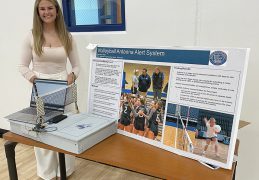National Food Safety Month
Written by: Nick Manning, Sports Medicine and Fitness Technology Student, KU Fort Lauderdale
National food safety month was created over twenty years ago to heighten the awareness about the importance of food safety. Millions of people fall ill every year and many die as a result of eating unsafe food. The most common symptoms of foodborne illness are fatal to the elders and the youth. Food contamination undermines food exports, tourism, livelihoods of food handlers and economic development, both in developed and undeveloped countries. Foods containing harmful bacteria, viruses, parasites or chemical substances are responsible for more than two hundred diseases. It is important to store our food safely, starting from the farm all the way to our plate!
Sports Eye Safety Month
Written By: Michael Casiano, Sports Medicine and Fitness Technology Student, KU Fort Lauderdale
Every year 100,000 Americans suffer sports related eye injuries, with 42,000 requiring emergency room treatment. These injuries range from minor corneal abrasions, which can take several days to heal, or the more serious sports-related eye injuries such as an orbital fracture or a detached retina – both of which are potentially blinding. Some of the highest risk sports include baseball, basketball, football, racquetball, golf, lacrosse, hockey, tennis, soccer, fencing, paintball and even fishing. The good news is that 90% of these injuries can be prevented with the use of proper protective eyewear. It is up to the individual participant to wear the correct eye protection because most sports do not require it. Here are a couple tips to remember about protective eyewear:
-
Eyewear and face shields should be made of polycarbonate, meet the requirements of the American Society of Testing Materials (ASTM), and be labeled “ASTM F803″ approved.
-
Sunglasses and prescription glasses/sunglasses do not provide adequate protection.
-
Protective eyewear can be fitted with prescription lenses.
-
Protective eyewear should be replaced when damaged or yellowed from age.
-
The lenses of protective eyewear should pop outward when struck to prevent damage to the eye.
-
Purchase eye protection that has an anti-fog coating or venting.
-
Always try eye protection on before purchasing to make sure that it is the proper fit.
-
For use under a helmet, choose goggles rather than eyeglass style.
Remember, it is your responsibility to protect your own eyes!
Youth Sports Safety
Written by: Sanjay Williams, Sports Medicine and Fitness Technology Student, KU Fort Lauderdale
Sports are a great way for youth to exercise and learn about teamwork and discipline. However, sports may come with a few injuries whether minor or severe. Severe injuries include broken bones and head injury whereas a less severe injury could include sprained muscles and minor bruises.
Enforcing youth sports safety includes providing the proper instruction to the rules and techniques necessary to engage in the sport. Proper supervision is required to prevent potentially dangerous behavior. To make sure youth are safe when participating in sports, we must make sure the appropriate equipment is being used (shoes, padding, helmet, etc.) Proper use of the helmet is important because it may reduce the risk of a potential concussion. A concussion could result in long term health ramification and cognitive problems.
In conclusion, to enforce and promote youth sport safety we should follow the guidelines of wearing proper protective equipment, keep the body hydrated, and provide proper supervision for youth participating in sports.
STUDENTS: Please email your submissions/questions/comments to the ELSE Student Editor, Kayla Bianchi at: [email protected]








 My instructors believed in me. They were more than instructors, they tried to get to know you as a person and tried to understand your goals so they could push you towards them. Student services helped me find a job before I even graduated. Everyone was dedicated to my overall success.
My instructors believed in me. They were more than instructors, they tried to get to know you as a person and tried to understand your goals so they could push you towards them. Student services helped me find a job before I even graduated. Everyone was dedicated to my overall success.
